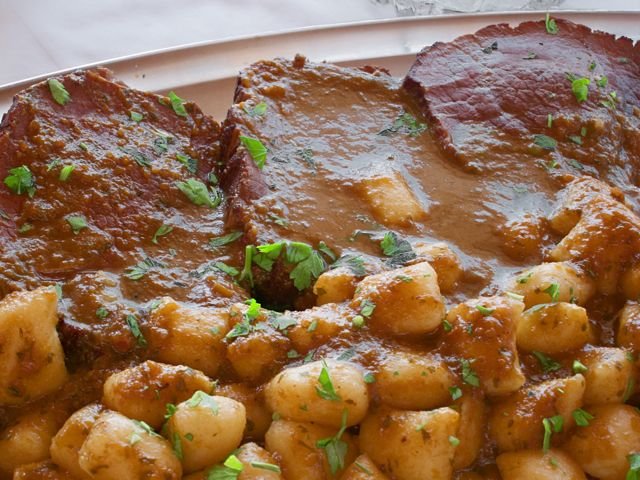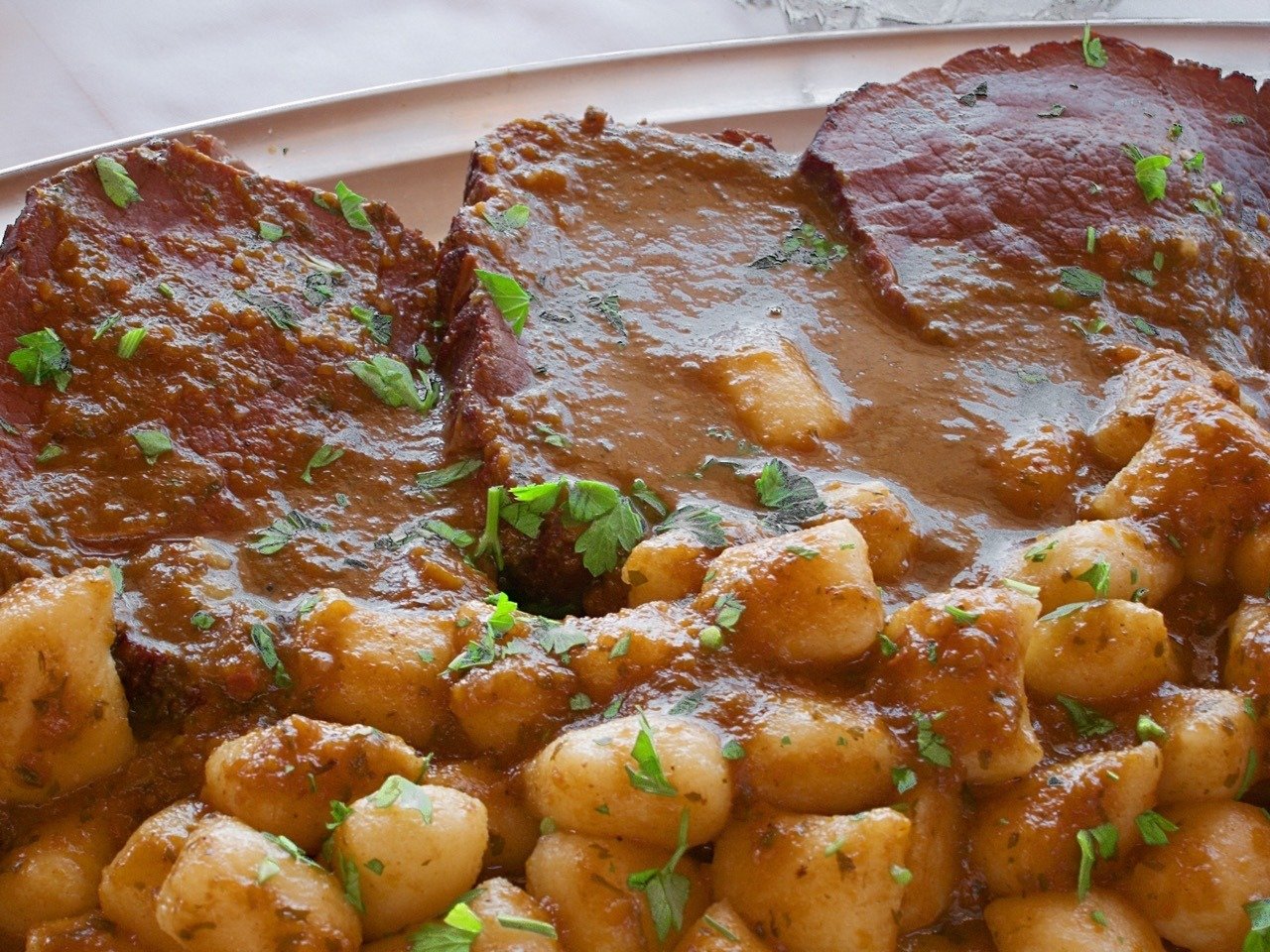Pašticada is the holy grail of Dalmatian Croatian cooking, for me. Here in Dalmatia, this stewed beef dish is prepared with an exceptional sauce. You may know it as Dalmatinska pašticada, Dalmatian Pot Roast, or even just as beef stew, but whatever you call it requires long and meticulous preparation.
I feel blessed that I was given this recipe to share with you all from the award-winning chef Mario Mandarić who is the head chef at La Gitana restaurant, located on the island of Hvar. This recipe is his personal spin on the traditional recipe.
La Gitana is on my list of places to visit when it opens up in summer. It’s located on one of the oldest historical squares in Stari Grad. They offer a blend of traditional Dalmatian hospitality with a mix of originality, both in and out of the kitchen.
A friend of mine who visited the restaurant when it opened last year said it’s a “charming rustic restaurant that offers a tasty blend of Spanish and traditional dalmatian cuisine.”
Here is what you need for this pašticada recipe

Pašticada Recipe (Beef Stew)
This pašticada recipe is the holy grail of Dalmatian Croatian cooking. In Dalmatia, this stewed beef dish is prepared with a very special sauce.
Ingredients
Pašticada
- 2 kg (4.4 lbs) beef, top round (you can also use topside, silverside or rump) You want the back end of the cow
- 20 g smoked/dried bacon (0.7 oz)
- 200 g onions (7 oz)
- 150 g parsley root (5.3 oz)
- 150 g carrot (5.3 oz)
- 50 g celery root (1.8 oz)
- 2 garlic cloves
- 20 g tomato paste (0.7 oz)
- 200 ml cooking oil or olive oil (1 cup)
- Apple cider
- 10 g cloves (0.35 oz)
- 10 dried plums, diced
- 6 dried figs
- 2 apples, peeled and quartered
- 300 ml red wine (1 1/4 cups)
- 2 Tbls. mustard
- 3 bay leaves
- Small bunch of thyme
- Rosemary leaves
- Cooking chocolate (75% cocoa)
- Salt
- Pepper
Gnocchi
- 2 L of milk (8.5 cups)
- 1,200 g flour (type 550) (9.5 cups)
- 60 g butter (4 Tbls.) cut into small cubes
- 20 g of ground nutmeg (0.71 ounces)
- Pinch of salt
- A few drops of olive oil
Instructions
Pašticada
- Wash and wipe the meat and then insert the pieces of bacon in it using a knife. Salt, as desired, spread mustard over the meat and place it in the “pajc” (a container with a mixture of the apple cider vinegar and oil enough to cover the meat). Let it marinate like this for at least 5 hours (overnight, preferably)
- Brown the meat in hot oil (all sides). Remove it from the pan and quickly sauté the chopped onion, garlic, and vegetables
- Return the meat to the pan along with the red wine & simmer covered for about 2 hours. If required, add small amounts of red wine mixed with water and touch of sugar (dalmatian prošek works great as a replacement for this) as the meat cooks – it needs to be tender
- When the meat is tender, add tomato concentrate, diced prunes, and figs along with the apple quarters
- At the end of the cooking, stir in the bay leaf, rosemary, thyme & minced cloves
- Add pepper and a little salt, try it and, if necessary, add a little bit of cooking chocolate. Balance the flavor with a bit of red wine and plums in order to get a sweet & sour taste to your liking
- Remove the meat, cut it into slices, and place on a heated plate
- Purée the vegetables with roast the drippings and pour it over the meat
- Serve with gnocchi and a slice of lemon
Gnocchi
- Pour milk into a medium-sized container and let it boil
- Add the nutmeg, salt, butter, and olive oil
- When the milk boils, remove it from the heat and gently mixing with a wooden spoon, add flour
- When you add all the flour, mix it well enough so that it all merges into a single substance similar to dough. After you achieve that, leave it for 3-4 hours to cool completely
- Remove the dough, divide it into two or three parts, shape each of them into a roll, and cut it into identically sized pieces.
- Cook the gnocchi in boiling water for 12 minutes and serve as a side dish to pašticada



Is this recipe scaled for the restaurant? Seems like it could feed the proverbial army. I’ve had similar recipes (heavy on nutmeg but light on fruit) and can’t wait to try this one. Not sure about the gnocchi, though. What are butter flakes?
It’s just 2kg of meat. Amerikanka, you should know better than anyone you have to have ‘extra, just in case’ someone wants 3 plates or pops over unexpectedly. Imagine the shame if there was nothing to offer :)
Yeah, “just” 2 kilos, LOL. Sure, if I’m entertaining, “extra, just in case” is the rule. For family dinner, this Jenki leans towards portion control. I hate cooking to stick stuff in the freezer. These measurements are easily cut in half, though.
Out of curiosity, I googled butter flakes and I see that it’s some kind of store-bought baking product, often pre-added to AP flour for “biscuit” flour. I guess that’s like butter-flavored shortening. People in the American South swear by butter-flavored commercial products – where I live we use butter!
Ohhh man, I love a good freezer meal. I love not cooking when Mr. CtD is away. I emailed my friend who translated this recipe for me to ask what the chef ACTUALLY wrote for those butter flakes… stay tuned :)
Okay as promised those buttler flakes, was just a mistranslation – in fact it’s regular butter in small pieces / cubed :) Great pick up there, thanks so much!!
Even with likes of Vegeta, I couldn’t imagine anyone there using something known as “butter flakes”! I have nothing against preparing meals specifically for the freezer, but I hate freezing and re-heating leftovers of a meal I’ve eaten. The cycle of freezing-heating I keep to a minimum for the sake of flavor – and more importantly, texture.
This is my very favourite dish that my mum and I do for every special occasion .i do make my gnocchi or njoke with potatoes though . To answer Amerikanka’s question the receipe for the gnocchi is missing a line,there is no quantity for the butter flakes (I imagine them to be just grated butter) but there is probably a fair amount of it as there are no potatoes just flour ,we need SJ to find out the amount as I would like to try to make this out .I love old traditional receipes !!
I’ve never tried Croatian food before but all your recipes including this makes me want to try it. I’ll try the recipe.
I’ve never tried Croatian food before, not even once… I have to look at your other recipes
Thank you for sharing
Wow this looks amazing, I’d love to try this recepie xx
Emily@londonmummyoftwo.com
Wow, I’ve never seen such an interesting twist on beef stew (apples, figs, cloves?!) and… no potatoes?? I’ll need to try it to believe it!
This restaurant in on Hvar – it may be open when you come.
Thanks SJ.
was tasting this dish a couple of times here, delicioso !
About the “njoki”, I believe (no, I am súre :-) in dalmatia potatoes are added (no big deal, but makes them slightly more tender).
On the meat: only two kilos ? (ha ha ha).
Thanks again, as I didn’t have the recipe of that delicious dish yet.
Seems however we can slowly start to think of grilling outside :-)
Ahh Pim, you’re back! We’ve missed you around here. My understand that this is the Hvar way of making the Njoki, and yup we add potatoes where I am from also.
Hooray spring is on its way! Our garden has already started blooming, has yours?
Its butter cut into small pieces, to melt faster, thats all. no butter flakes :)
if you have any questions about this recipe, feel free to ask me, i will be glad to help you.
Thank you for posting my recipe SJ :)
What is the UK cut of meat required for pasticada? Rump, sirloin, fillet, etc?
Can you please answer my previous question? What cut of meat are we talking about here? Topside, rump, sirloin?
Sure, happy to help. Sorry I was not answering comments as fast as usual this week, I have been ill. I have zero clue about UK cuts of meat, but a quick google serach led me to this this article on wiki: , which says that a round steak is a beef steak from the “round”, the rear leg of the cow. The round is divided into cuts including the eye (of) round, bottom round, and top round, with or without the “round” bone (femur), and may include the knuckle (sirloin tip), depending on how the round is separated from the loin.
I hope that helps you narrow the cut of meat down. When you do, let me know and I can update the recipe for others in the UK too. Have a wonderful day and thanks for stopping by.
Thanks for allowing us too Mario! I amended the recipe so it’c clearer now :)
Many thanks indeed for your help SJ. From your description it looks like a choice of topside, silverside or rump depending on your budget. As you say the back end of the cow!
Great! Lemme know how you get on with the dish… and send us a photo!! We’d love to see it.
I’m going to use this for a Mediterranean Christmas special in my little restaurant next month, it sounds perfect. I’ll be using topside as I will be cooking for approx 60people, although there will be other main course choices. I’ll let you know how I get on, and when I’m asked for the recipe(which often happens) I’ll put the customers on to you!! Thanks for helping me out
Oh wow, I am sure Chef Mario will be so glad that you love it. Report back and let us know what your guests think.
Everyone loved this dish, it was one of the stars of the menu that night! Very Christmassy and easy to make for a crowd. Behaves well if your guests(or customers in my case) want to take their time before eating as it sits happily in the oven. Thanks guys, happy customers and happy chef…x
That is so wonderful to hear :D Happy New Year!!
im so glad to hear that. thank you very much and Happy New Year
How long is the meat cooked in the oven and on what temperature please?
my favourite dish.
Thank you
I have done quite an extensive research re UK cuts of meet. It turns out that silverside is best option for pasticada but topside could be used for it too (this is according to fellow Dalmatians living here, some of whom are chefs). I discussed this with a butcher too who agreed. Hope this helps!
Awesome! Thanks a bunch Karmen, I’ll update the recipe soon to reflect that. Best wishes.
How many people does this recipe serve?
Magnificent site. Plenty of helpful information here I’ll be sharing this delicious recipe.
to what he calls the war of the pasticadas . In Dalmatia, every household has their own recipe, with secret ingredients carefully guarded and passed down from generation to generation, and naturally everyone claims theirs is the true pasticada. Barbieri says that the sweet-sour combination is typical of dishes from 1fea ancient Greece and the Levant. So the origins of pasticada could be more than two and a half thousand years old!
I’ll see if I can track down Chef Mandarić who wrote this recipe and let you know.
Hello, im here.
if you have any questions you can ask me on my email ; mariomandaric@hotmail.com
My Grandma made a stuffing from bread, eggs, ham and green onions with some herbs or spices she called Nadif. Do you have a recipe for that? It was boiled in a casing. We cannot buy this where I live. Wonder if there is a substitute for the casing.
Sorry, I have never heard of that, and can not even think what it might be.
It’s called nadjev.
https://www.jutarnji.hr/dobrahrana/price/goranski-nadjev-kralj-uskrsnjeg-dorucka-u-goranskom-kraju-5835771
Not sure what you could use as a casing substitute, but some people make it without any casing/casing substitute:
Awesome! Thanks so much Ang, I love learning new foods to try, super sweet of you to reply <3
It was called NADJEV probably which sounded like NADIV or NADIF. It just means stuffing in croatian.
I have made thus twice with topside. If I make it again I will use brisket or beef cheeks. Topside is too dry.
Pašticada should be dark (check en.wikipedia.org/wiki/Pašticada), slightly sour, and fork-tender. You marinate it in a mixture of vinegar and wine (not oil). You roast it, cook it, slice it, and cook again. Caramelizing the onions is key.
I have never eaten Pašticada that dark. I think you’ll find we each cook our own recipes slightly differently and some variation is acceptable.
How many does this recipe serve? Also what’s the heat of the oven please? Thank you